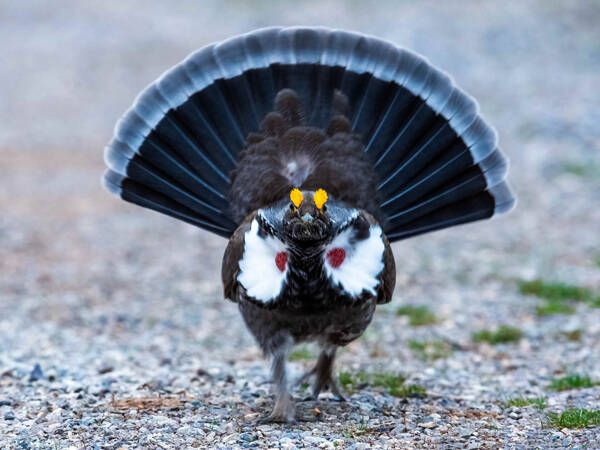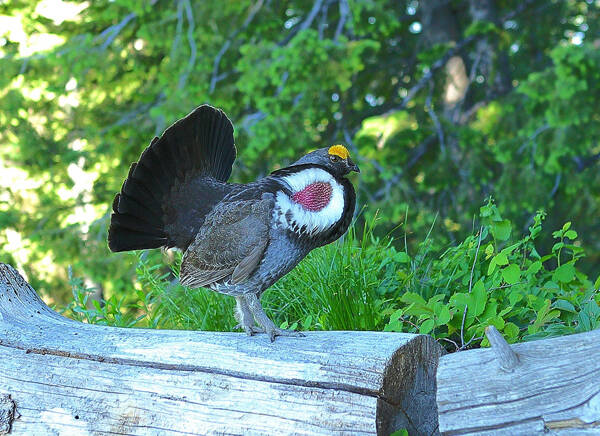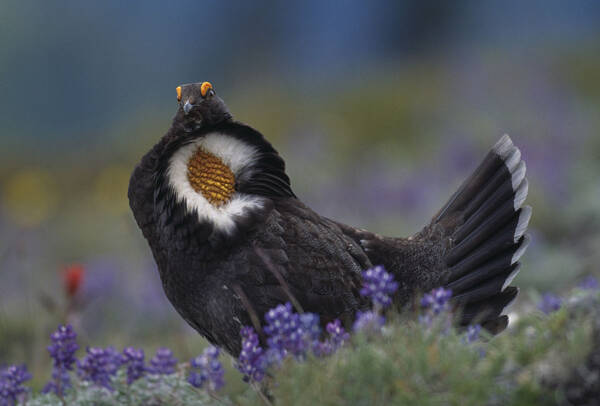Dendragapus obscurus
IUCN
LCBasic Information
Scientific classification
- name:Dendragapus obscurus
- Scientific Name:Dendragapus obscurus,Dusky Grouse
- Outline:Landfowl
- Family:Gallinomorpha G.family B.Genus
Vital signs
- length:44-57cm
- Weight:850-1245g
- lifetime:3-14years
Feature
North America is the second largest grouse
Distribution and Habitat
The geographic range is very wide, from the Northwest Territories in northern Canada to northern New Mexico in the United States. Covering the western half of North America, it is inhabited in the Rocky Mountains along with other neighboring mountainous areas, such as South Dakota, Wyoming, and Nebraska's Black Hills. The area covers about 2.1 million square kilometers and has a high elevation.
Blue grouse live in a wide variety of environments, from mixed forests of aspen to hawthorn near sea level to dense forests of Douglas fir, pine and spruce. They use these areas for different purposes throughout the year and migrate in between. During the summer, these grouse spend their time in subalpine meadows or low-lying areas that are rich in aspen, cherry, berry and oak seeds, as well as grasshoppers that live with them, and are an important food source for blue grouse at this time of year. In winter, most other animals seen in the mountains have migrated to lower elevations, whil
Appearance
The second largest grouse in North America, the blue grouse is a relatively large grouse, with males measuring 47-57 cm long and weighing an average of 1245 grams. The female is 44-48 cm long and weighs an average of 850 grams. The male chicken is bigger than the female. At first glance, males and females are indistinguishable. Upon closer examination, the male is predominantly gray or SLATE with a lack of black breast, while the female is a mixture of off-white and white. Both sexes have a scalloped tail with a gray band along the tip of the tail feathers. During the spring mating season, males display red patches of skin surrounded by white feathers on both sides of their chests, while the square fan-shaped tail is spread out to attract females. During the breeding season, the species has a prominent eye comb, especially in the spring. The male's eye comb is yellow-orange in color and covers the entire upper half of the eye. The female's eye comb covers only the upper inner
Details
The blue Grouse (Dendragapus obscurus), also known as Dusky Grouse, is a relatively large grouse with four subspecies.

Blue grouse tend to form smaller groups in the warmer months and larger groups in the winter, spending most of their time at the top of trees feeding on needles or pine seeds. In summer, the small flock usually consists of one female bird and about six or seven chicks. In winter, clusters of 15-20 individuals are observed. This is due to the greater density of the covering of the food during these times. In areas where food is less abundant, many small groups may become more numerous when food becomes scarce, and in the summer these birds have a richer diet, such as blueberries, cherries or gooseberries, and therefore scatter among the bushes to feed.
Blue grouse are arboreal and diurnal birds that migrate vertically and are territorial. It lives in an alpine wooded environment in the winter and enters areas with lower food sources in the summer. They tend to use the same areas year after year. The chicks follow their mother and continue to migrate between these areas as they age. These grouse usually travel short distances, but in some cases blue grouse travel up to 30 miles between summer and winter.
Blue grouse communicate socially throughout the year through a series of chirps. These sounds are very subtle to the human ear and are difficult to distinguish from other forest birds. These sounds are used to alert each other to predators and are particularly common between a mother and her chicks. If the mother and chick are separated, the mother will summon her chick with a series of deep breathing sounds similar to those given by the male chicken during the breeding season. During mating season, male chickens use burping to communicate with females. With these sounds, the male chickens beat their wings in succession, producing a series of thumping sounds. This pattern and sound are also used to defend their territory and to summon the female.

Blue grouse roost in the winter on tall spruce, Douglas pine and other conifers, which grow needles and pine cones that provide them with food. The blue grouse's favorite is the seeds in the cones of the white pine during this period, which are rich in protein and fat, providing these birds with a nutrient-rich diet to help them survive the colder months. In the summer, blue grouse can feed on a variety of bushes growing berries such as blueberries, cherries, gooseberries, and bilberries, as well as a large number of insects, especially grasshoppers. The birds rely on small gravel (a muscular organ located at the base of the neck) in the crop to crush up large chunks of food. When food is digested enough, it enters the stomach and intestines, where nutrients can be absorbed.
Mating occurs in spring to mid-summer, from late March until mid-July. Male chickens defend a mating territory with sound and fight, flapping their wings and tail feathers. The males congregate in a preferred area and the females pick the males, or the males go out alone to find females ready to mate. Females can continue into the mid-summer season in an attempt to attract females that have lost contact and are willing to mate again. The mating system is mixed. Once bred, the female finds a fallen tree or brush and builds a nest out of grass and twigs. An average of 7-9 eggs are laid per litter. The spawning season varies according to the weather and in different regions, but is usually in March. Incubation period is 18-21 days. Chicks begin to hatch in late May and early June. If a hen loses her chicks in early summer, she will often mate with a willing male.
After the eggs hatch, the chicks are protected from predators and intruders under the care of the hen, who will scare intruders with hissing and wing flapping. The male grouse does not take part in caring for the chicks. After the chicks reach 10-28 days of age, the hens and chicks begin to forage separately, but the hens are still often found perched on the chicks' bodies, protecting and watching out for intruders. In early autumn, the chicks will leave their mother for independence and join other subadult chicks in a group.

Blue grouse have a fairly short life span, losing 50% of their chickens in the first year. The average lifespan of a blue grouse that survives its first year is about three years. In areas where food is plentiful and predation low, blue grouse can live up to 14 years.
The blue grouse has a wide range, strong reproductive capacity, does not approach the vulnerable endangered threshold criteria for species survival (distribution area or range of less than 20,000 square kilometers, habitat quality, population size, fragmentation of distribution area), and stable population trends, so it is assessed as a species without survival crisis.
Listed on the International Union for Conservation of Nature (IUCN) 2016 Red List of Threatened Species ver 3.1 - Not Threatened (LC).
Protect wild animals and eliminate wild meat.
Maintaining ecological balance is everyone's responsibility!








